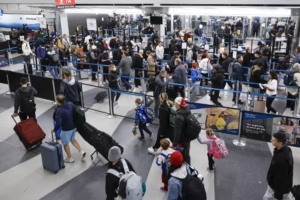On Thursday, Challenger, Gray & Christmas released a labor-market update that added to the grim sentiment on Wall Street.
Due to a near-blackout of official economic data brought on by the continuing government shutdown in the United States, investors are looking for private offerings that could offer some insight into the state of the job market.
Investors discovered something to cling onto on Thursday, and it seems that many of them weren’t pleased with what they saw. U.S.-based companies reported 153,074 job cutbacks in October, up 175% from the same month last year and up 183% from those disclosed in September, according to the most recent data from Challenger, Gray & Christmas, a firm that releases a monthly update on hiring and firing activities. That was the greatest total for any month since 2008 and the highest for October in 20 years.
The report fueled a rebound in bonds that drove the yield on the 10-year Treasury note BX:TMUBMUSD10Y back down toward 4%, but some on Wall Street blamed it for causing a further selloff in stocks on Thursday. Inversely correlated with price, bond yields decrease as prices increase.
According to FactSet data, the selloff caused the S&P 500 SPX to drop more than 1% in recent trading. The most recent decline, which came after the index had its lowest day in almost a month on Tuesday, put the S&P 500 on pace for its worst weekly performance since October 10. The index was down roughly 2.9% from its closing high, which was recorded in late October.
The significance of job numbers for high-priced equities
Throughout this three-year bull market, concerns have often been raised about the tech companies’ disproportionate gains in comparison to the rest of the stock market.
If those concentrated bets begin to unravel, as they did during the tariff crisis in April, investors who are following a tiny group of high-flying tech stocks may suffer excruciating losses, according to the theory.
The market has also been supported by the argument that the surge could easily continue as long as American families are employed.
As investors missed the Labor Department’s official jobs report for the second consecutive month, Thursday’s Challenger, Gray & Christmas data was added to a recent collage of unimpressive labor market signals. This appeared to exacerbate long-standing worries about exorbitant stock market prices, bubbles in speculative industries, and uncertainties over the sustainability of the artificial intelligence industry.
According to the Challenger analysis and October’s ADP statistics, which was made public earlier this week, companies with less than 50 employees have laid off more than 130,000 jobs since April. “This is an upward trend,” according to Luke Tilley, chief economist at M&T Bank and Wilmington Trust.
Tilley told MarketWatch, “Small firms have cut a lot of jobs since the implementation of tariffs.” Even though smaller businesses make up around one-third of all jobs in the area, he pointed out that, in contrast to large public organizations, those layoffs typically go unnoticed.
“I think there is so much uncertainty about the path of the economy going forward that it’s going to lead to wider swings in markets,” Tilley stated.
Employed versus fired
In addition to announcing layoffs on Thursday, the Challenger numbers also included hiring data. After analyzing the data, Brent Donnelly of Spectra Markets created a chart that contrasted the number of new hires with the number of job losses over a 12-month rolling period. He demonstrated in remarks provided to MarketWatch on Thursday that the number of jobs lost has surpassed the number of new recruits by the largest margin in roughly 15 years.
“If job doom is your religion, this chart is a prophecy of imminent flood,” Donnelly stated in the report.
Indeed, there are problems with the Challenger data. According to Donnelly, it is not seasonally adjusted and can be far noisier than the Labor Department’s official nonfarm-payrolls report.
“I would trust NFP much more – but we don’t have NFP,” he stated.
The substantially quicker pace of layoffs in October was likely caused by a few variables, according to Andy Challenger, chief revenue officer for Challenger, Gray & Christmas. Following a global hiring boom that led many businesses to hoard workers, certain industries are reducing staff.
However, rising AI adoption, easing business and consumer spending, and cost-driven belt-tightening also probably had an impact.
“Those laid off now are finding it harder to quickly secure new roles, which could further loosen the labor market,” Challenger stated in a press release published Thursday morning after the latest figures were released.
The image of the job market has grown more dire as a result of more private payroll data. According to Revelio Labs’ estimate on nonfarm payrolls, the number of jobs decreased by 9,000 in October. The corporation stated that employment losses in the government sector were “predominantly driven by that decline.”
The top figure from ADP’s report on private payrolls, which was made public on Wednesday, was also present. 42,000 jobs were added last month, according to that statistics, which was more than economists had predicted. However, Tilley of M&T Bank noted that there were indications of vulnerability beneath the surface.
“The labor market is the key,” Tilley stated. “That’s where we are.”





